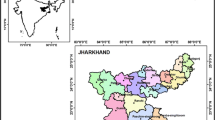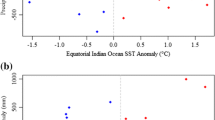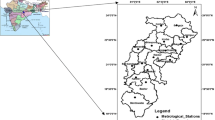Abstract
The purpose of the present study is to analyze the annual and seasonal precipitation trends in the prefecture of Arcadia, in Greece. Data series are based on records of 10 ground-based meteorological stations plus the available CRU TS 4.05 data series for Greece and for the geographic region of Peloponnese. The study contains a 30-year reference period from 1980 to 2009 and the last decade from 2010 to 2020. Homogeneity and serial correlation tests are considered in the analysis. Mostly negative trends are observed in annual and seasonal (except summer and irrigation period) series of reference period, with the majority of the significant trends to be in irrigation and autumn periods. The observed negative trends of the reference period tended to be transformed into positive trends over the last decade. Regarding the CRU TS 4.05 precipitation data, weak negative annual trends were observed during the reference period. However, significant positive trends were observed during autumn and irrigation periods. In the last decade, significant positive trends were detected during summer and irrigation periods.





Similar content being viewed by others
Data availability
The datasets generated during and/or analyzed during the current study are available from the corresponding author on reasonable request.
References
Alexandersson H (1986) A homogeneity test applied to precipitation data. J Climatol 6:661–675
Bardossi A, Pagram G (2014) Infilling missing precipitation records – a comparison of a new copula-based method with other techniques. J Hydrol 519(A):1162–1170. https://doi.org/10.1016/j.jhydrol.2014.08.025
Buishand TA (1982) Some methods for testing the homogeneity of rainfall records. J Hydrol 58:11–27
Dalezios NR, Bartzokas A (1995) Daily precipitation variability in semiarid agricultural regions in Macedonia, Greece. Hydrol Sci J 40:569–585. https://doi.org/10.1080/02626669509491445
Feidas H, Noulopoulou N, Makrogiannis T, Bora-Senta E (2007) Trend analysis of precipitation time series in Greece and their relationship with circulation using surface and satellite data: 1955–2001. Theor Appl Climatol 87:155–177. https://doi.org/10.1007/s00704-006-0200-5
Forland E et al (1996) Changes in “normal” precipitation in the North Atlantic region, Klima Report 7/96. The Norwegian Meteorological Institute, Oslo
Gofa F, Mamara A, Anadranistakis M, Flocas H (2019) Develo** gridded climate data sets of precipitation for Greece based on homogenized time series. Clim 7(5):68. https://doi.org/10.3390/cli7050068
Hamed KH, Ramachandra Rao A (1998) A modified Mann-Kendall trend test for autocorrelated data. J Hydrol 204:182–196
Harris I et al (2020) (2020) Version 4 of the CRU TS monthly high-resolution gridded multivariate climate dataset. Sci Data 7:109. https://doi.org/10.1038/s41597-020-0453-3
Kalimeris A, Founda D, Giannakopoulos C, Pierros E (2012) Long-term precipitation variability in the Ionian Islands, Greece (Central Mediterranean): climatic signal analysis and future projections. Theor Appl Climatol 109:51–72. https://doi.org/10.1007/s00704-011-0550-5
Kambezidis HD, Larissi IK, Nastos PT, Paliatsos AG (2010) Spatial variability and trends of the rain intensity over Greece. Adv Geosci 26:65–69. https://doi.org/10.5194/adgeo-26-65-2010
Karpouzos DK, Kavalieratou S, Babajimopoulos C (2010) Trend analysis of precipitation data in Pieria region (Greece). Eur Water 30:31–40
Kendall, MG (1955) Rank correlation methods. 2nd edn. Charles Griffin, London
Lagouvardos K et al (2017) The automatic weather stations NOANN network of the National Observatory of Athens: operation and database. Geosci Data J 0:1–13
Mann HB (1945) Nonparametric tests against trend. Econometrica 13:245–259
Margaritidis AK (2021) Site and regional trend analysis of precipitation in central Macedonia, Greece. Comput Water, Energy, Environ Eng 10:49–70. https://doi.org/10.4236/cweee.2021.102004
Mavromatis T, Stathis D (2011) Response of the water balance in Greece to temperature and precipitation trends. Theoret Appl Climatol 104:13–24. https://doi.org/10.1007/s00704-010-0320-9
Myronidis D, Stathis D, Ioannou K, Fotakis D (2012) An integration of statistics temporal methods to track the Effect of drought in a shallow Mediterranean lake. Water Resour Manage 26:4587–4605. https://doi.org/10.1007/s11269-012-0169-z
Nastos PT (2008) Spatial and temporal variation of rain intensity in Greece, in: Proceedings of 8th international hydrogeological congress, Athens, Greece, 651–660, 2008.
Nastos PT, Zerefos CS (2007) On extreme daily precipitation totals at Athens, Greece. Adv Geosci 10:59–66. https://doi.org/10.5194/adgeo-10-59-2007,2007
Nastos PT, Zerefos CS (2008) Decadal changes in extreme daily precipitation in Greece. Adv Geosci 16:55–62. https://doi.org/10.5194/adgeo-16-55-2008,2008
Nastos PT, Zerefos CS (2010) Climate change and precipitation in Greece. Hell J Geosci 45:185–192
Osborn TJ, Hulme M, Jones PD, Basnett TA (2000) Observed trends in the daily intensity of United Kingdom precipitation. Int J Climatol 20:347–364
Paliatsos AG, Nastos PT, Tzavelas G, Panagiotakos DB (2005) Characteristics of precipitation in urban Athens area, from 1891 to 2000. Fresen Environ Bull 14:422–428
Patakamuri SK, Muthiah K, Sridhar V (2020) Long-term homogeneity, trend, and change-point analysis of rainfall in the Arid district of Ananthapuramu, Andhra Pradesh State, India. Water 12(1):211. https://doi.org/10.3390/w12010211
Pettitt AN (1979) A non-parametric approach to the change-point detection. Appl Stat 28:126–135
Philandras CM, Nastos PT, Kapsomenakis J, Douvis KC, Tselioudis G, Zerefos CS (2011) Long term precipitation trends and variability within the Mediterranean region. Nat Hazards Earth Syst Sci 11:3235–3250. https://doi.org/10.5194/nhess-11-3235-2011
Pnevmatikos JD, Katsoulis BD (2006) The changing rainfall regime in Greece and its impact on climatological means. Meteorol Appl 13:331–345. https://doi.org/10.1017/S1350482706002350
Schönwiese CD, Rapp J (1997) Climate trend atlas of europe—based on observations 1891-1990. 1997th edn. Kluwer, Dordrecht
Sen PK (1968) Estimates of the regression coefficient based on Kendall’s tau. J Am Stat Assoc 63:1379
Ventura F, Rossi Pisa P, Ardizzoni E (2002) Temperature and precipitation trends in Bologna (Italy) from 1952 to 1999. Atmos Res 61:203–214
Von Neumann J (1941) Distribution of the ratio of the mean square successive difference to the variance. Ann Math Stat 13:367–395
Wijngaard JB, Klein Tank AMG, Können GP (2003) Homogeneity of 20th century European daily temperature and precipitation series. Int J Climatol 23(6):679–692. https://doi.org/10.1002/joc.906
World Meteorological Organization (2014) Climate data management system specifications. WMO-No.1131, Geneva, pp 1–166
World Meteorological Organization (2018) Guide to climatological practices. WMO-No. 100, Geneva, pp 34–76
Acknowledgements
The author wishes to thank the Northern Kynouria Municipal Water supply and Sewerage Company for the opportunity to conduct the relevant research study.
Author information
Authors and Affiliations
Corresponding author
Ethics declarations
Conflict of interest
The author declares no competing interests.
Appendices
Appendix 1. Homogeneity tests
1.1 Alexandersson’s standard normal homogeneity test (SNHT)
For an annual series Xi (i is the year from 1 to n) with mean “X” and standard deviation “s,” a statistic T(k) to compare the mean of first “k” years of the record with that of last “n − k” years is described as
where
If a break is located at year “K,” then T(k) reaches a maximum near the year k = K. The test statistic T0 is defined as
The null hypothesis is rejected when T0 is above the critical value, which depends on the sample size. Probability p was computed using the Monte Carlo method (using 2 × 105 simulations).
1.2 Buishand’s range test
In Buishand’s range test for an annual series Xi (i is the year from 1 to n) with mean “X” and standard deviation “s,” the adjusted partial sums are defined as
For a homogeneous series, the value of S ∗ k fluctuates around zero, as no systematic deviations of the Xi values with respect to their mean will appear. When a break point is present in the series, the S ∗ k value reaches a maximum value (negative shift) or minimum value (positive shift) near the year k = K. The (S ∗ k/s)/√n is depicted in the graphs representing the results of this test. The significance of the shift can be tested using “rescaled adjusted range” denoted as R, which is the difference between the maximum and minimum of the S ∗ k values scaled by the sample standard deviation.
R/√n values are compared with the critical values of Buishand (1982) to test for significance.
1.3 Pettitt’s test
Pettitt’s test is a nonparametric rank test. The ranks r1, r1, …, rn of the series X1, X2, …, Xn are used to calculate the test statistics as
When a break occurs at year K, the statistic is maximum or minimum at year k = K,
The value of Yk is compared with critical values given by Pettitt (1979) to test for statistical significance.
1.4 Von Neumann’s ratio test
For an annual series Xi (i is the year from 1 to n) with mean “X,” the Von Neumann ratio “N” is defined as the ratio of the mean square successive (year to year) difference to the variance, given as
If there is a break in the series, the value of N tends to be lower than the expected value. If there is a rapid variation in the mean, the values of N may rise above two. This test does not indicate the exact location of the break year.
Appendix 2. Trend detection methods
2.1 Autocorrelated Mann–Kendall test
The Mann–Kendall test is a nonparametric test for monotonic trend detection. It does not assume the data to be normally distributed and is flexible to outliers in the data. The test assumes a null hypothesis, H0, of no trend and alternate hypothesis, Ha, of increasing or decreasing monotonic trend. For a time series Xi = x1, x2, …, xn, the Mann–Kendall test statistic S is calculated as
where n is the number of data points, xi and xj are the data values in time series i and j (j > i), respectively, and sign (xj – xi) is the sign function as
Statistics S is normally distributed with parameters E(S) and variance V(S) as given below:
where n is the number of data points, m is the number of tied groups, and tk denotes the number of ties of extent k. Standardized test statistic Z is calculated using the formula below:
To test for a monotonic trend at an α significance level, the alternate hypothesis of trend is accepted if the absolute value of standardized test statistic Z is greater than the Z1-α/2 value obtained from the standard normal cumulative distribution tables. A positive sign of the test statistic indicates an increasing trend and a negative sign indicates a decreasing trend.
According to variance correction approach proposed by Hamed and Ramachandra Rao (1998), recently used by Patakamuri et al. (2020), when the time series exhibit a significant serial correlation, the following modified variance V(S)* of the Mann–Kendall test was used
The proposed correction factor CF is
where rk and rkR are the lag − k serial correlation coefficients of data and ranks of data respectively and n is the total length of the series. In the case of correction factor (CF), only significant correlation coefficients are used.
2.2 Sen’s slope estimator
The Sen’s slope method (Sen 1968) is a robust nonparametric method of estimating the magnitude of trend slope. For a given time series Xi = x1, x2, …, xn, with N pairs of data, the slope is calculated as given below:
Median of N values of βi gives the Sen’s estimator of slope β
Rights and permissions
Springer Nature or its licensor (e.g. a society or other partner) holds exclusive rights to this article under a publishing agreement with the author(s) or other rightsholder(s); author self-archiving of the accepted manuscript version of this article is solely governed by the terms of such publishing agreement and applicable law.
About this article
Cite this article
Sakalis, V.D. Trend analysis of annual and seasonal precipitation data in Arcadia region (Greece). Bull. of Atmos. Sci.& Technol. 3, 8 (2022). https://doi.org/10.1007/s42865-022-00052-1
Received:
Accepted:
Published:
DOI: https://doi.org/10.1007/s42865-022-00052-1




